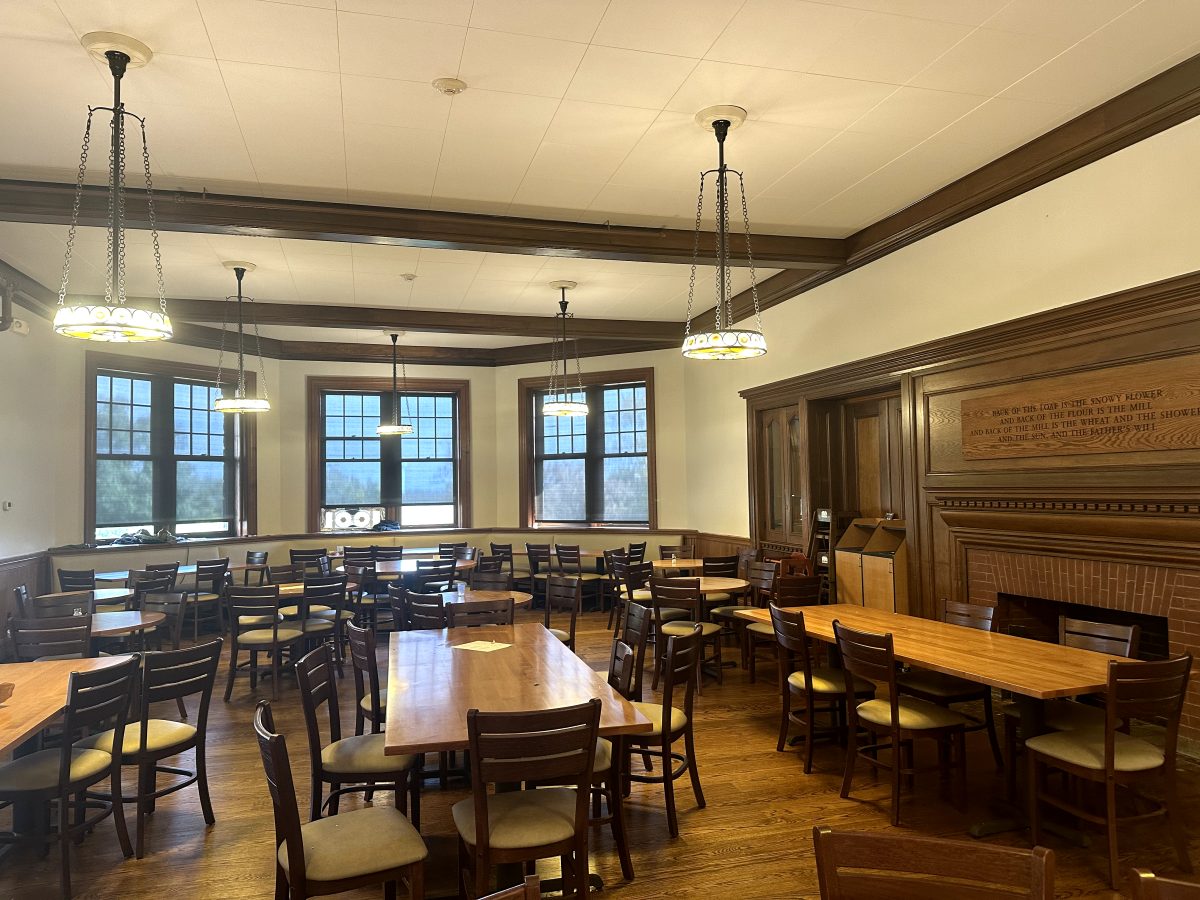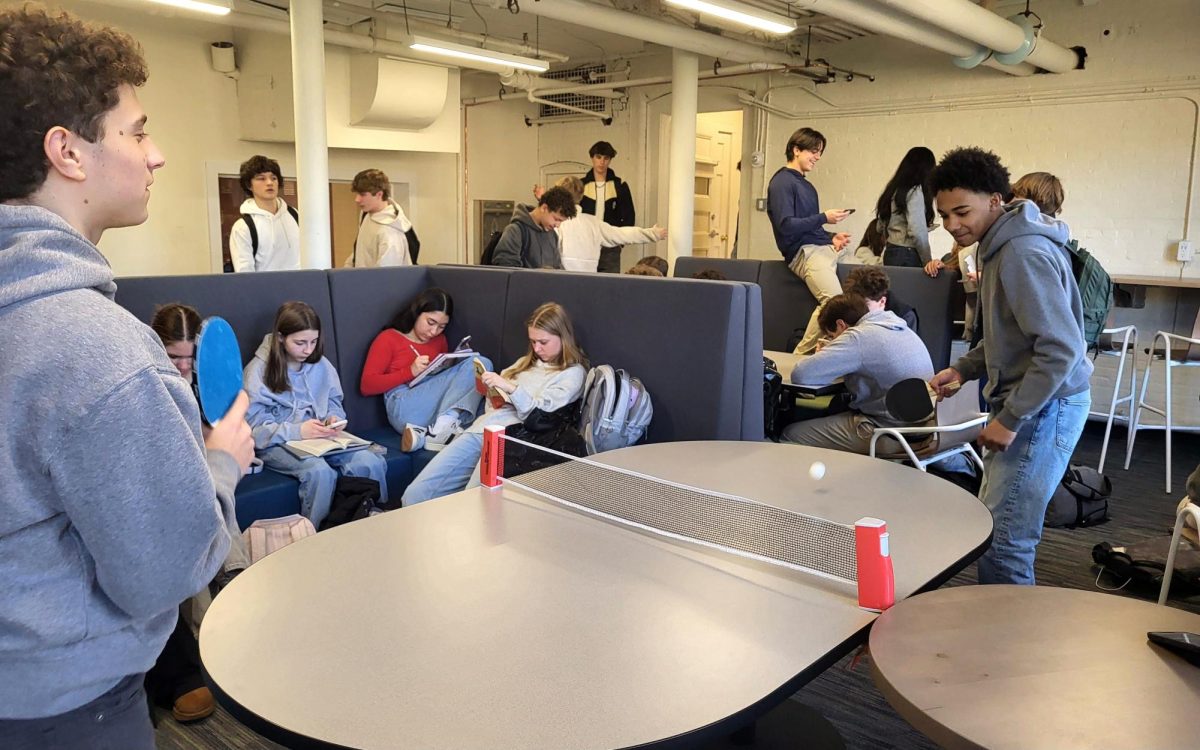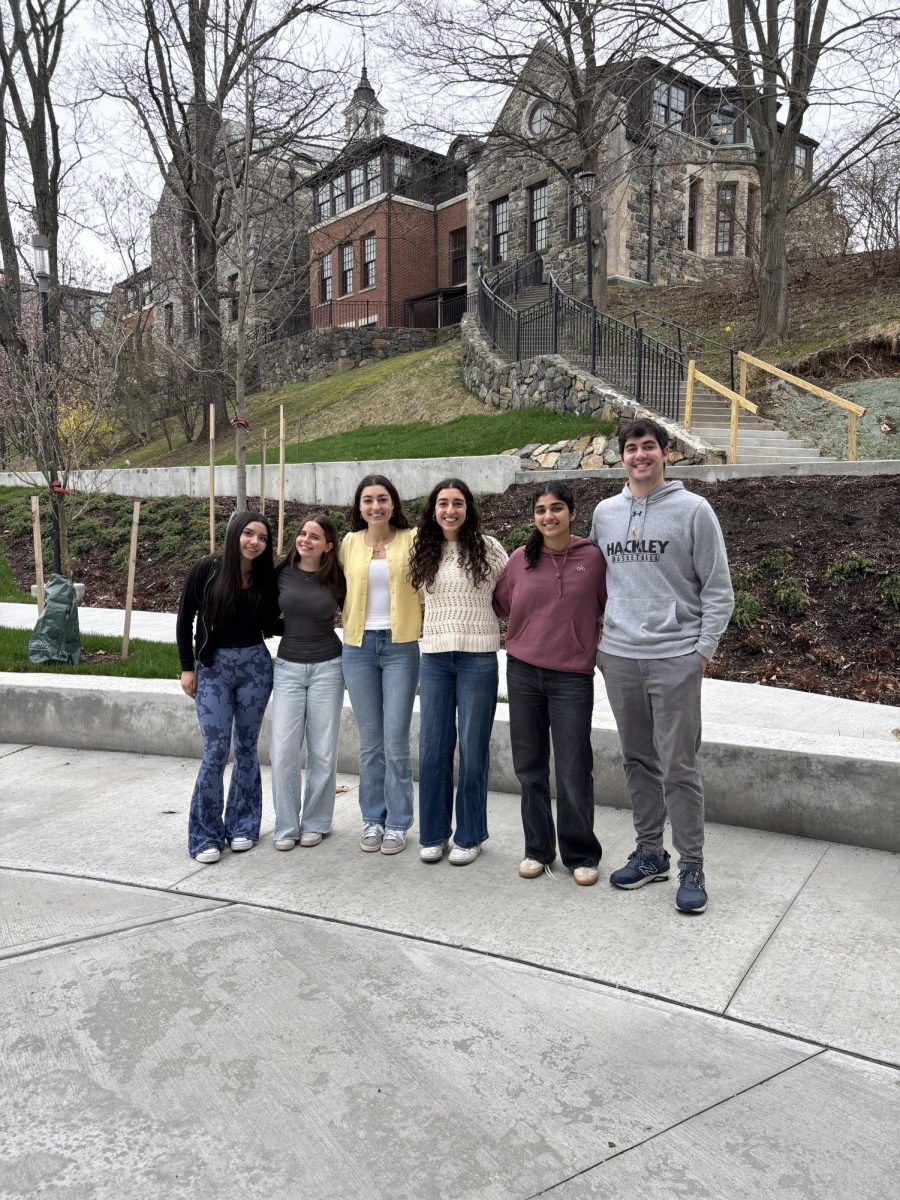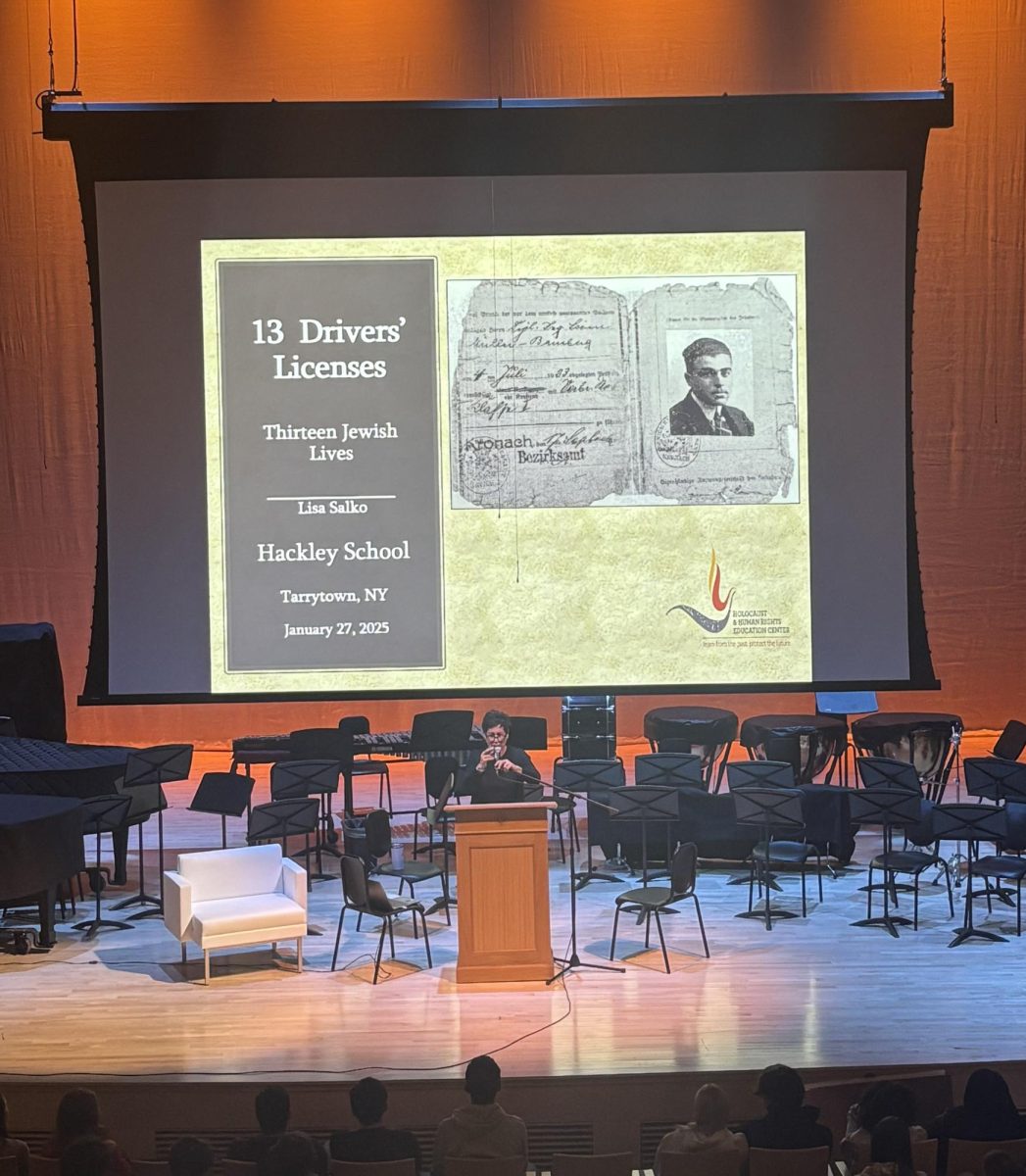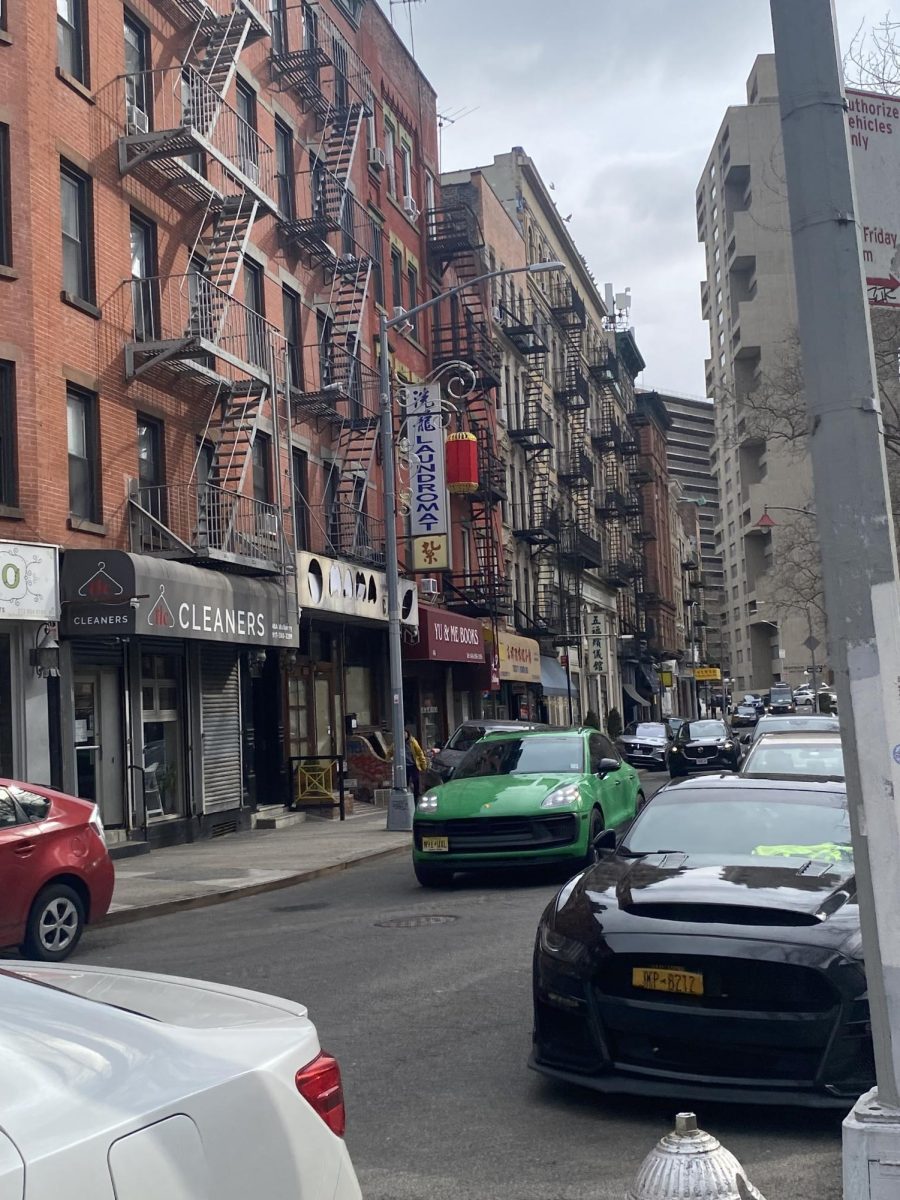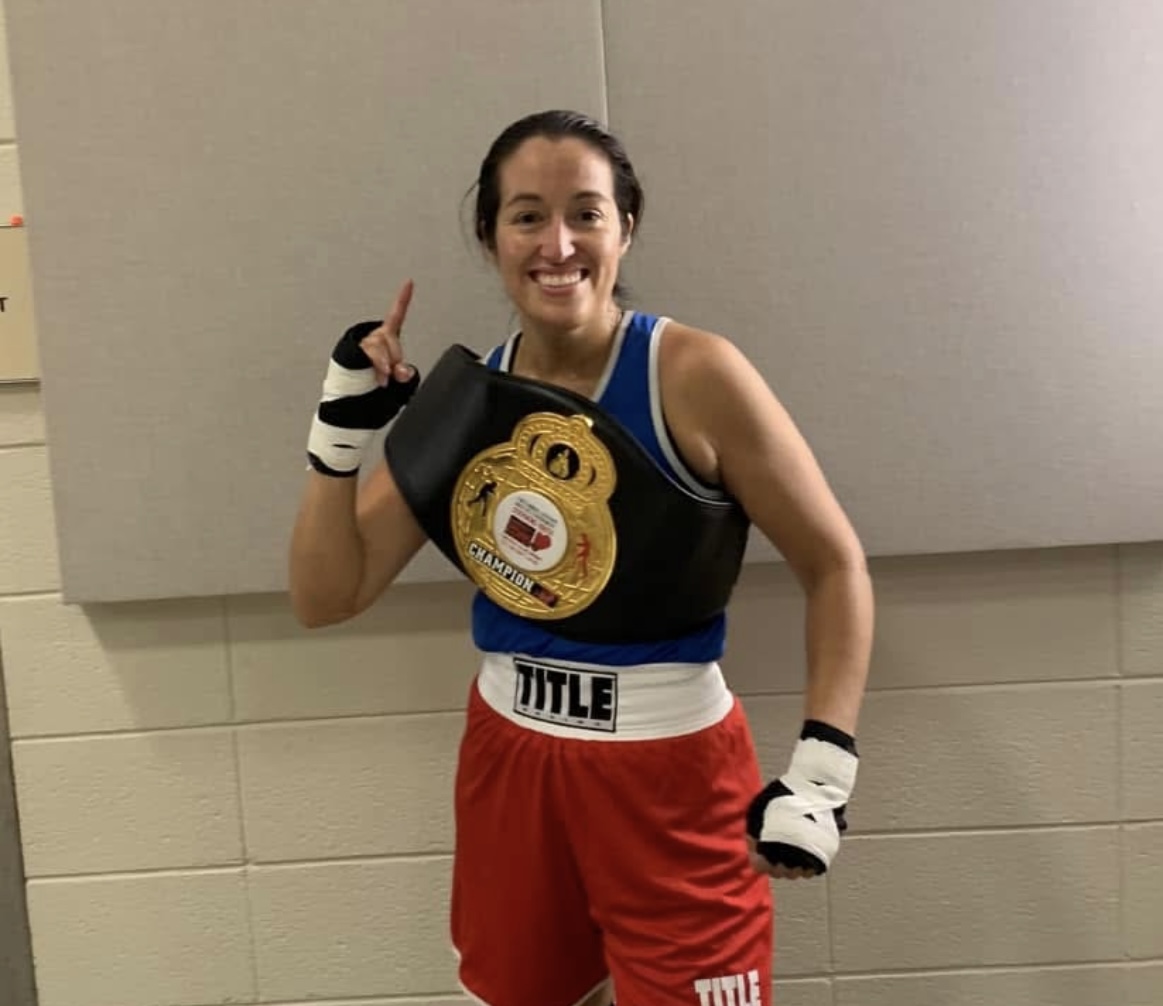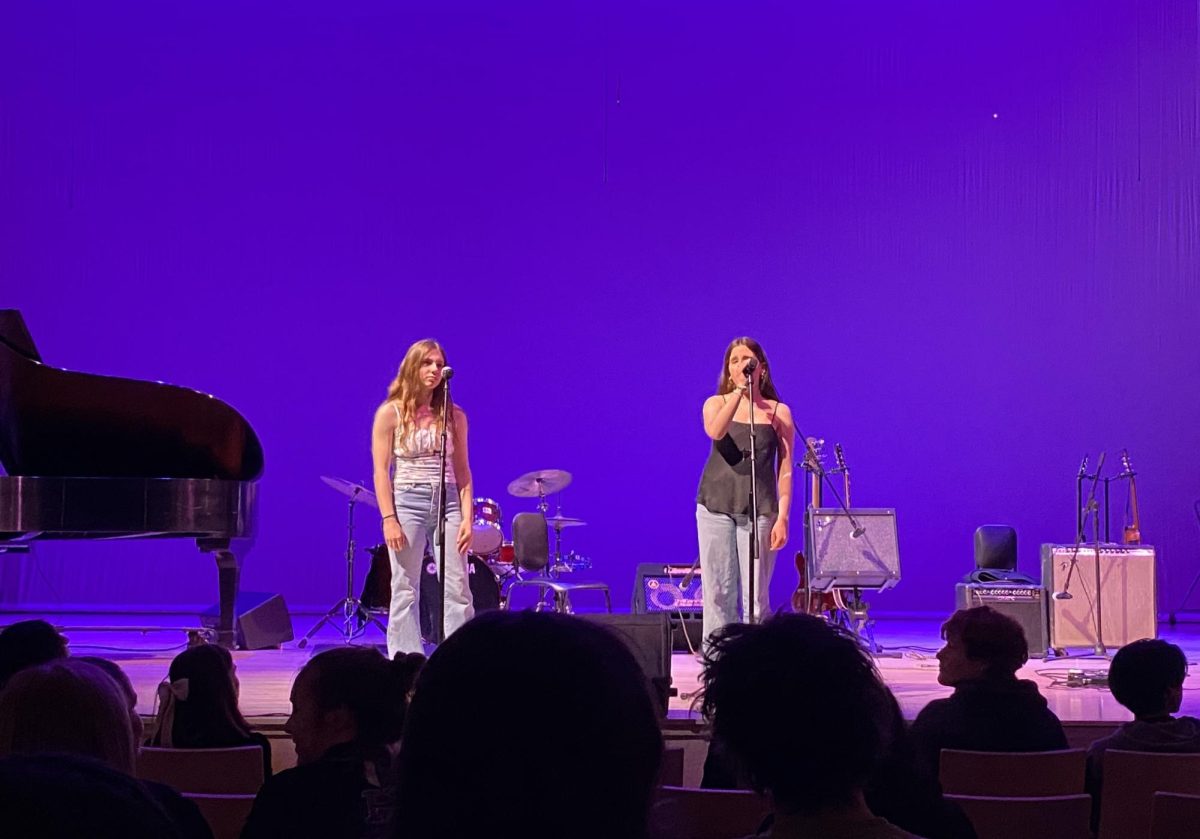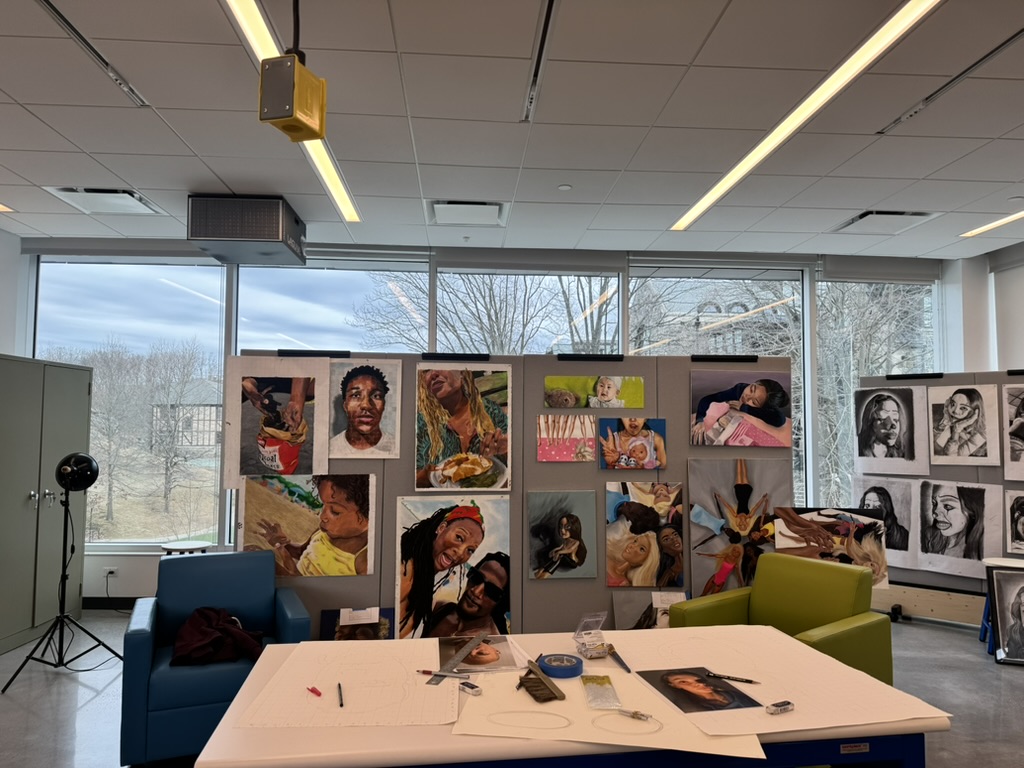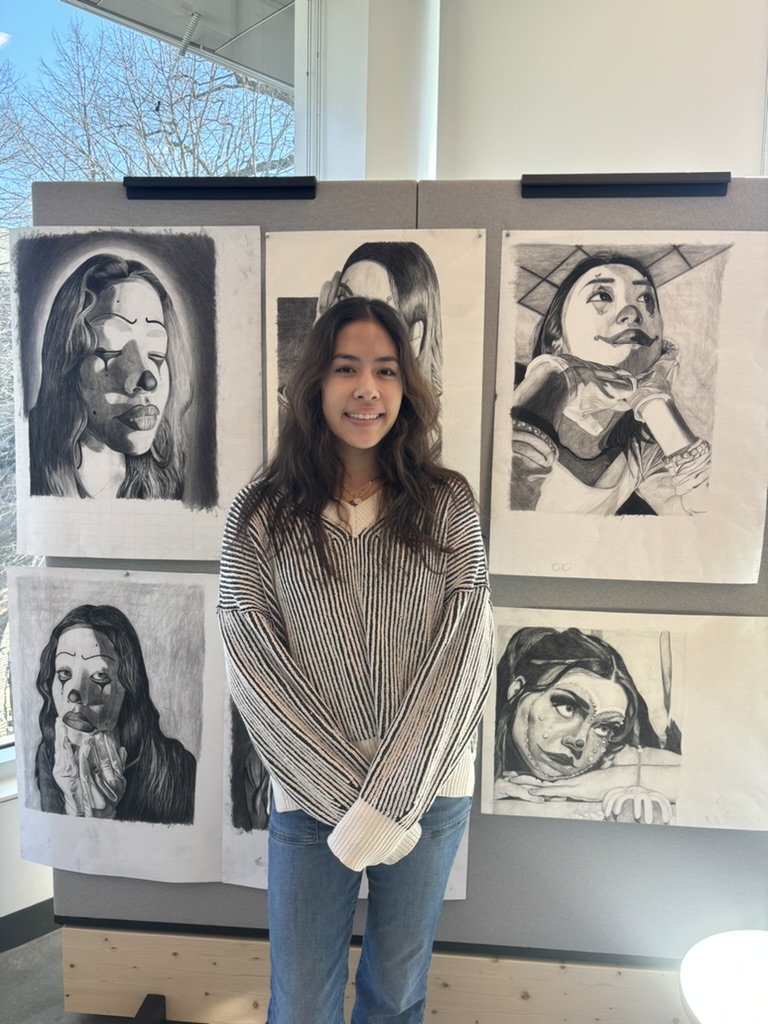Anticipation was palpable as students and faculty filled up the Lindsay Room last month to hear about the Israel/Hamas war. “The Hackley community is very interested in learning more, they’re very open to new ideas, and they just have a desire to better understand the world around them,” said Senior Aiden Wasserman.
On Friday, October 13th, the History department hosted a roundtable during lunch to inform students about the war between Israel and Hamas. Christopher Loomis, History Department Chair, introduced the roundtable discussion, as well as sent information about it to students and faculty. Mr. Loomis worked with Upper School Director Andy King and Upper School History teachers Michael Bass and Vladimir Klimenko to put together the program.
The history department has done roundtables relating to current events in the past, such as the Ukraine-Russia War, the Supreme Court Dobbs v. Jackson decision overruling Roe v. Wade, and U.S. relations with China. In the past, when the history department hosted roundtables, they started with a presentation and ended with a Q&A. According to Mr. Loomis, another reason for doing this was because they knew that students and faculty did not all have the same level of knowledge on the conflict, and wanted everyone to have something to base their questions off and to further develop the discussion.
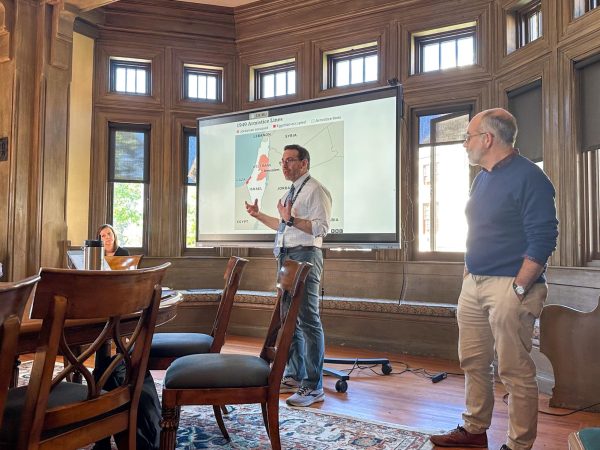
History teacher Michael Bass shows students and faculty a map in the Lindsay Room. Throughout the presentation, various maps and timelines were shown to students, with explanations given by Mr. Klimenko and Mr. Bass. Students and faculty attended the roundtable, listening attentively to the presentation.
“The purpose of the presentation was really nothing more than two things: one, establishing a background framework for understanding the conflict, and two, in that context, appreciating how complicated the conflict is,” said Mr. Klimenko.
Mr. Bass and Mr. Klimenko started by giving a presentation about the historical and geographical context of the conflict, using a PowerPoint consisting mainly of maps and timelines. To choose the information to put in the presentation, they chose crucial chronology and key points in the conflict, according to Mr. Klimenko.
Describing why they chose to use timelines, Mr. Klimenko said, “The conflict between Israel and the Palestinians is in many ways a conflict over land. That’s not the whole story, but it’s an essential piece of how and why the conflict came to be. So when discussing the tension between Israelis and Palestinians it’s quite useful to tell a chronological story with a map that illustrates events as well as aspirations.”
Mr. Bass and Mr. Klimenko first shared that the conflict started around the time when the Ottoman Empire controlled the land. Ottoman control was challenged by World War I, and the Sykes-Picot Agreement was a 1916 treaty that divided up Ottoman Land between Britain and France in anticipation of winning the war; however, the terms of the treaty were not consulted with those who lived in the territory.
The British ended up taking over this territory, wanting to support Zionism, the idea that Jewish people should have a homeland in Palestine, which emerged in the 1890s after pogroms against Jewish people in Eastern Europe and other antisemitic events like the Dreyfus Affair in France in which a Jewish French officer was framed for treason. After that background, Mr. Bass and Mr. Klimenko described how the state of Israel was established and why it led to conflict after Arabs rejected the 1947 UN partition plan. They gave an overview of several key events including the Six-Day War, the First Intifada, the Oslo Accords, and the Second Intifada, and the movement to build Israeli settlements in the West Bank. They used several maps to illustrate these events.
It’s estimated that 75 students attended, a good showing for an event of this type. Many students were looking for more information about the conflict, including junior Annabel Previdi who attended the roundtable hoping to gain more knowledge about the war and the history behind it. For example, she had no idea that the British were involved in the conflict.
After the presentation was over, the floor was opened up for students to ask questions. First, a student asked about how Saudi Arabia and Iran came together to condemn violence against Palestinians, and what this meant, especially in terms of the relationship between Israel and Saudi Arabia. Mr. Bass and Mr. Klimenko replied saying that within Saudi Arabia, they are split on who to support. Saudi Arabia is ruled by Mohammed bin Salman Al Saud, who is the prince and Prime Minister. He is more pragmatic and interested in peace agreements, while Salman of Saudi Arabia, former prime minister and current king of Saudi Arabia is more pro-Palestiniane. While Salman of Saudi Arabia is no longer prime minister, he is still involved in the country’s politics. Mr. Bass and Mr. Klimenko said that this is an example of why the war has ramifications for the entire world, as countries have to recalibrate their political positions.
Next, a student asked about U.S. involvement in the war. They answered saying that the U.S. is an ally of Israel, but people in the U.S. sympathize with both sides, which might have an impact on our elections. President Joe Biden has been mainly supportive of the Israeli response and, the Secretary of State, Anthony Blinken, met up with Benjamin Netanyahu, the Israeli Prime Minister, in Israel. Since the roundtable took place, President Biden has met with Prime Minister Netanyahu in Tel Aviv, Israel, and has helped deliver aid to civilians in Gaza, saying that it was crucial civilians have access to food, water, medical assistance, and other aid. It was also mentioned that prior to the attack Israel had been facing internal conflict over proposed changes to the powers of the Supreme Court that some Israelis think would make Israel less democratic. Some believe those protests may have made Israel vulnerable to attack. Mr. Bass and Mr. Klimenko also mentioned that Israel asking Gazans to move south is problematic, especially considering the size of Gaza as it is 25 miles long, but contains two million people. Logistically, moving South is extremely difficult for people who live in Northern Gaza, and Hamas leaders have told Palestinians not to move.
Another student asked about what the outcome would be if either Hamas or Israel did win the war. Mr. Bass said that engagement from the rest of the world is necessary – but the world is divided.
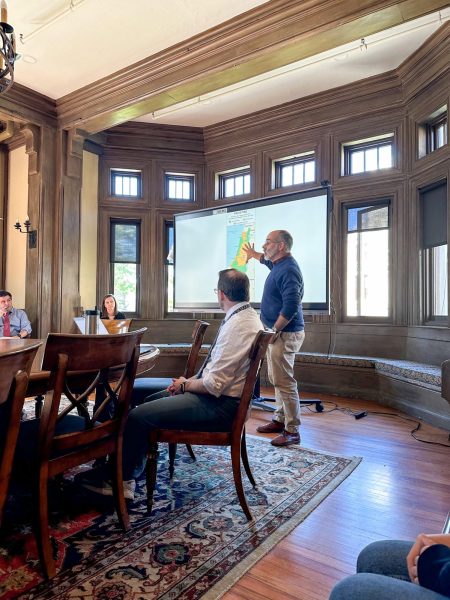
Upper School history teacher Vladimir Klimenko shows students a map of Israel and Palestine from the US General Assembly in 1947. Once Mr. Bass and Mr. Klimenko were done presenting, they opened up the floor for students to ask questions.
Sophomore Ben Iaderosa asked about the relationship between Hamas and Hezbollah, a political party and militant group in Lebanon, which is also designated a terrorist organization by the United States among other countries. The history teachers explained that Hezbollah is also backed by Iran, and if Iran can foil Israel’s blockade of Gaza, Hamas can build up stocks of weapons. President Biden and his administration have told Hezbollah and other groups to not get involved in the conflict. Another thing mentioned by the history teachers is that the majority of the war has taken place in Gaza, rather than the West Bank, where the majority of Palestinians live (three million). The West Bank has historically been a place of conflict, because of Israeli settlers and occupation there, but Hamas does not govern the West Bank. However, since the roundtable took place, the Israeli military launched an airstrike at a mosque in the Palestinian refugee camp Jenin in the West Bank, killing two people.
Ben said, “I didn’t necessarily know that the reason why the United States sent an aircraft over was because of the multiple rockets and how Hezbollah is armed, and keeping them at bay. And I asked a question about that.” Other students, including Annabel, did not know about the impact Hezbollah could have on the war.
Another student asked about the effect of the war on the whole region, not just Israel and Palestine. The teachers mentioned that it could definitely involve other countries; Syria is currently in a civil war and the U.S. has troops there, and these events could affect that. Additionally, there are other Jihadist groups in northwest African countries like Chad that could potentially interfere.
Lastly, a final student asked about when the atrocities become immoral, and not just the product of war. Mr. Bass and Mr. Klimenko answered saying that there isn’t a clear-cut way to enforce international law. The United Nations chief urged a ceasefire, although this has not happened partially because the UN doesn’t have its own forces to enforce its resolutions. In addition, the United States has vetoed resolutions proposed because Biden’s administration believes the wording of the resolutions does not do enough to recognize the severity of the attack and Israel’s right to defend itself. They said there are possible war crimes being committed on both sides, and Israel’s blockade of water, food, energy, etc. is making this worse. They ended by saying that the nature of modern warfare is extremely brutal.
Annabel commented on what she thought about the roundtable, saying, “I think it helped a lot. I liked how the presentation had a lot of maps. I think visually seeing what’s going on is a lot more effective than hearing it. I think that it emphasizes how complex the problem is and how both sides have valid reasons to be upset.”
In addition to the questions that students asked, Mr. Bass and Mr. Klimenko provided the following information about the history of the conflict. They said that the idea of having a national identity could also be partially attributed to the creation of Israel, especially in places that were colonized by European countries, as many ethnic groups did not have their own country.
In the 1920s and 1930s, as more Jewish people began settling on the land mapped out by Britain, Palestine and other countries in the area rejected the settlement. Several Arab countries launched attacks to conquer the land, and Israel replied, eventually driving Palestinians out of much of the land they were living in in 1948. Mr. Bass and Mr. Klimenko also highlighted that up until the 1980s, the conflict was more between Israel and Arab Countries, rather than between Israelis and Palestinians. Palestinians would often rise up on occupied territories using a variety of methods such as riots and demonstrations, as well as more violent attacks, although many Palestinians maintain that their protests are generally peaceful.
The presentation also included the Oslo Accords of 1993, agreements made between Israel and Palestine in an effort to make peace. However, this process ultimately broke down without a lasting agreement.
Israelis had been occupying land in Gaza, and in 2005, Israel moved them out of Gaza. Two years later, in 2007, Hamas took over as the governing group in Gaza, one of the Palestinian territories. Mr. Bass and Mr. Klimenko told students that a critical question throughout the history of the conflict is whether or not it can be resolved or if a two-state solution can be accepted by both Israelis and Palestinians.
Another important detail included in the presentation was the relationship between Israel and Saudi Arabia, as well as Palestinians and Iran. Mr. Bass and Mr. Klimenko explained how Saudi Arabia and Iran have been in conflict, with Israel recently improving their relationship with Saudi Arabia. That has caused alarm among Iran’s leaders. On the other side, Hamas, the terrorist group that rules Gaza and that launched the attack on October 7, is backed by Iran, including Iran providing funding and weapons.
Mr. Klimenko stressed that it’s important to understand this conflict for many different reasons, especially because the world is experiencing heightened tensions after the COVID-19 pandemic. He stated, “The world is a complicated place and right now this particular region almost feels like the epicenter of what might be the next chapter of global instability.”


